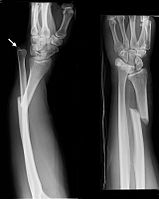
Photo from wikipedia
The basilar thumb joint is the joint second most commonly affected by osteoarthritis (OA) in the hand. Evaluation of dorsal subluxation of the thumb during a functional task such as… Click to show full abstract
The basilar thumb joint is the joint second most commonly affected by osteoarthritis (OA) in the hand. Evaluation of dorsal subluxation of the thumb during a functional task such as key pinch could help assess OA risk. The objectives of this study were to determine the best imaging angle for measuring thumb dorsal subluxation during key pinch and to compare subluxation to corresponding OA grades on the Eaton-Glickel, Outerbridge, and ICRS scales. Eleven cadavers cadveric forearm specimens were rigged to simulate key pinch. A mobile c-arm captured AP view images of the hand, and rotating in 5° increments toward the ulnar aspect of the arm up to 60°. Dorsal subluxation was measured on each image and compared to determine which angle captured maximum subluxation. The resulting best imaging angle was used for comparisons between dorsal subluxation of the thumb and OA grades for the basilar thumb joint. The max subluxation was in the AP view for most specimens. There was a significant correlation between subluxation and the Eaton-Glickel grade (p=0.003, R2 = 0.779), but not with either Outerbridge grades (p=0.8018) or ICRS grades (p=0.7001). Dorsal Our results indicate that dorsal thumb subluxation during key pinch should be measured in the A-P view of the forearm/handhand view. Dorsal thumb subluxation during key pinch had a significant correlation with the Eaton-Glickel radiographic measure of OA but not with more accurate visual classifications of OA.
Journal Title: Journal of biomechanical engineering
Year Published: 2021
Link to full text (if available)
Share on Social Media: Sign Up to like & get
recommendations!